
Education Modernization for Digital 21st Century
“Customized learning will help many more students succeed in school.
Student-centric classrooms will increase the demand for new technology.
Computers must be disruptively deployed to every student.
Disruptive innovation can circumvent roadblocks that have prevented other attempts at school reform.
We can compete in the global classroom-- and get ahead in the global market.”
—Clayton Christensen, Ph.D.; Professor of Business Administration at Harvard University, regarded as a world expert on innovation and growth.
With wide-spread adoption of the internet, many of the world’s most developed countries are expanding from an industrial economy to a knowledge economy. Creation of knowledge, information, and innovation is becoming an intrinsic part of the global economic system, along with labor and capital. For the US to remain competitive, citizens must gain the skills.
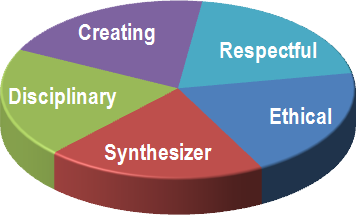
Recently, Howard Gardner, Ph.D., defined "Five Minds For the Future" which are the cognitive abilities that will command a premium in the years ahead. The disciplined mind has deep continuous domain expertise by mastering an important subject. The synthesizing mind has skills to understand and evaluate information from disparate sources, making meaningful associations while circumventing false or unproductive ones. The creating mind formulates valuable new ideas and perspectives, and innovates new things. The respectful mind has knowledge of and respect for diverse cultures with a global perspective. The ethical mind acts as a 'good citizen' in difficult team and global situations.
Bloom's Taxonomy on Levels of Human Thought
Bloom's Revised Taxonomy classifies human thought into six levels from the least to the most complex.
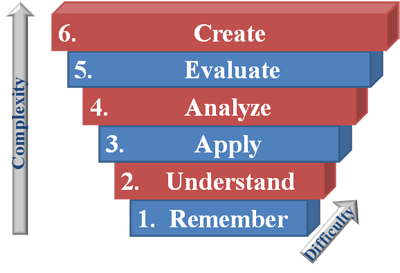
The bottom three levels of the taxonomy, remember-understand-apply, describe thought processes where the person recalls and uses what is known and comprehended to solve a problem. These are considered basic skills. In the upper three levels, analyze-evaluate-create, the person makes discoveries and gains new insights to solve current problems innovatively or solve new problems. These are right brain and integrated brain activities.
Complexity and difficulty describe completely different dimensions of mental processing. Examples along the increasing complexity dimension are:
Remember - retrieving relevant knowledge from long-term memory: What is 1+2?
Understand - construct meaning: Give examples of when to use math fact 1+2=3.
Apply - use addition algorithm with multiple digits: What is 121 + 212?
Analyze - distinguishing between relevant and irrelevant numbers in a simple addition word problem: I have 12 apples, 17 carrots, and 21 bananas. How many pieces of fruit do I have?
Evaluate - judging which of multiple addition methods is the best way to solve a given problem: Should you use Partial-Sums Addition, Column Addition, or U.S. Traditional Addition algorthim for the word problem above?
Create - reorganizing concepts into a new pattern: Generate a hypothese to account for observed phenomenon in the word problem above.
Along the difficulty axis, addition, multiplication, subtraction, and division are of increasing difficulty. For remember math facts level, Examples along the increasing difficulty dimension are:
1+1=2
1*2=2
2-1=1
2÷1=2
Each complexity level can have increasing difficulty. It is not necessary to wait to high school to teach the higher cognitive levels. A six month old has the concept of magnitude, bigger-smaller, even before they can say the words or remember facts. Preschoolers can and have been taught at the Analyze level with those same concepts, building cognitive skills and providing the motivation to learn the facts.
Teaching styles
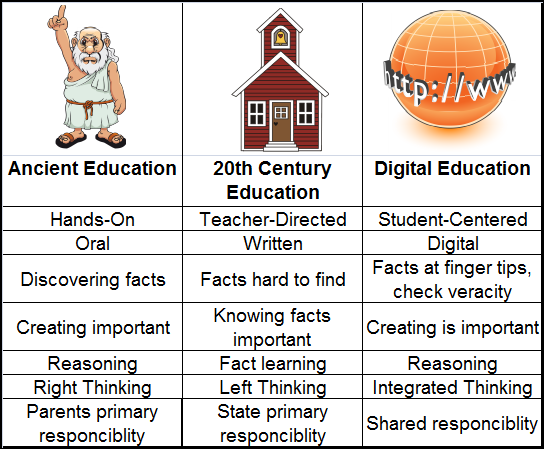
In 2003-04 the National Center for Education Statistics reproted that the average age of US public school teachers was 42.5 years old, and percentage by gender: 2003-04. Therefore, most of current teachers are 20th century teachers. Current student teachers are being taught by 20th Century professors. Twentieth century teachers and professors were taught left brain teaching styles for only the bottom three Bloom's levels.
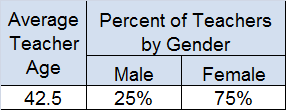
Visual learners were excluded from classrooms or supported by aids which did not have a teaching degree. Expectations and assessments were less.
Although very necessary, new educational policy has dramatically changed the rules. Teachers are being asked to teach skills they were not trained for and possibly do not possess.
A growing number of education researchers understand the need for teachers and therapists to have a minimal neurobiology education to improve teaching styles. Recent studies have demonstrated that complex decisions are integrated or right brain functions, and visual thinking exists as part of the human neurodiversity. If future studies support Linda Silverman's data that 60% of the population are visual thinkers, the education system needs to learn how to teach them rather than tell them they are deficient. We want to reach a point when a child can say proudly they have Aspergers, and their peer responds by saying, "Hey, cool! Can you help me with my critical thinking?"
Visual thinkers naturally have 21st Century skills. How does the education system develop them?
“Unlike the diagnosis for strep throat, the diagnostic criteria for autism have changed with each new edition of the DSM. I warn parents, teachers, and therapists to avoid getting locked into the labels. They are not precise. I beg you: Do not allow a child or an adult to become defined by a DSM label.”
—Temple Grandin, Ph.D., Professor of Animal Science at Colorado State University, an autistic woman who is a world renowned expert on autism spectrum.
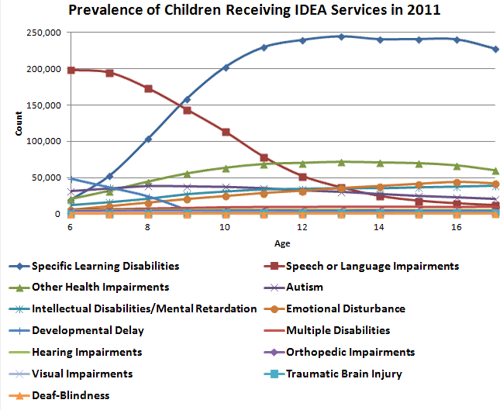
The Individuals With Disabilities Education Act (IDEA, passed in 1990) is a Federal law meant to give all children with learning disabilities an appropriate education in the least restrictive environment possible. The number of children and youth ages 3–21 receiving special education services under IDEA was 6.4 million in 2010–11, or about 13 percent of all public school students. An unknown additional number of children are labeled with learning problems without being formally entered into the program. As seen in the Prevalence of Children Receiving IDEA graph, the majority of children have a Specific Learning Disability, which means they not achieve adequately for the child's age or to meet State-approved grade-level standards in one or more of the following areas: oral expression, listening comprehension, written expression, basic reading skills, reading fluency skills, reading comprehension, mathematics calculation, or mathematics problem solving. The next largest group is Speech or Language Impairments. So 67% are visual thinkers with average to high IQs. Temple Grandin's objection is due to the average special education student not getting sufficient support to counteract the stigma and reduced expectations of the label. The average visual thinker will do better in adult life than school if not damaged by the school experience. In a study of 500 special education teachers, the teachers indicated they spent an average of one hour per week interacting one-to-one with each child. Paraeducators are becoming a major part of the special education process in delivering services and instruction to special needs children of all ages. In the US, 29% of the paraeducators have high school diplomas, 38% have completed some college, and 32% hold an associate’s degree or higher. Historically, paraeducators provided clerical tasks and assisted with functional living tasks. Dyslexics were found to get better reading instruction in the regular classroom.
Jacob Barnett was diagnosed with autism. At two years old, his mother was told he was unlikely to ever read or even tie his shoes and they suggested she place him in a special education program. He started college at 11 years old. Now 14 years old, Jacob is finishing his Master’s degree in condensed matter physics and shortly will starting his Ph.D.
Tommy is not so fortunate. His school district has a “One Label per Student” model. By policy, because he was diagnosed with Aspergers, he can not be considered for their gifted programs. The parents protested this. His school district knew he scored higher than 95% on his School and College Ability Test, and while in 6th grade he was tested by the John Hopkins Center for Talented Youth (CTY) at the 9th grade level. Tommy scored in the top 1% in math and top 3% in english at the 9th grade level, and was admitted into the CTY. Unfortunately, he lives in another state, so his involvement is limited.
The CEC Preparation Standards for Special Educators, approved December 2012, does not require neurobiology education for special education teachers or education requirements for paraeducators. Paraeducators are not licensed. They are supervised by a licensed special education professional. Tommy gets little support, but is precluded from programs that he could take advantage of. If his school district understood even minimal neurobiology this would not happen.
